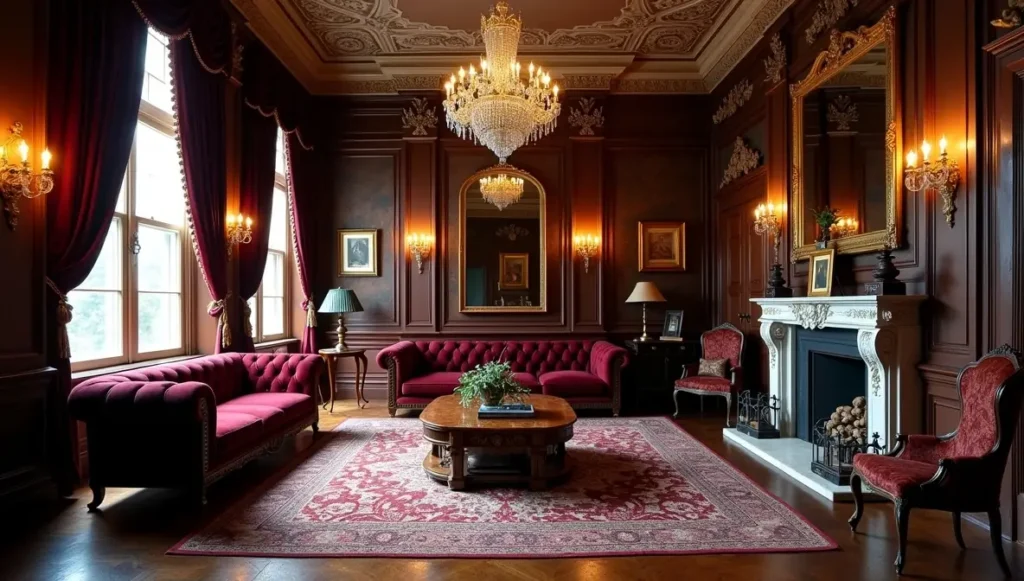- Victorian Interior Design: Creating Authentic Period Elegance in Your Home - September 6, 2025
- Why I’m Obsessed with Rococo Interior Design (And You Should Be Too) - September 4, 2025
- Hollywood Glam Interior Design: Bringing Old Hollywood Luxury Home - September 2, 2025
Table of Contents
I still remember walking into my first authentic Victorian home back in 2006 – a sprawling Queen Anne in San Francisco’s Pacific Heights. The owner, an elderly woman named Margaret, had inherited it from her grandmother and wanted to restore it “properly.” That project taught me more about Victorian design than any textbook ever could.
Victorian style gets a bad rap these days. People think dark, stuffy, overstuffed rooms that feel like funeral parlors. But here’s the thing – when done right, Victorian interiors are warm, inviting, and surprisingly livable. The Victorians weren’t trying to create museums. They were showing off their newfound prosperity while making homes that worked for large families and frequent entertaining.
Getting Victorian Color Right
Forget what you’ve heard about Victorian homes being all dark and dreary. Yes, they loved rich colors, but there was serious thought behind those choices. The deep burgundies, forest greens, and navy blues weren’t just fashionable – they were practical. Coal dust and soot were real problems, and these darker shades hid the grime between cleanings.
But here’s where most people mess up: they think Victorian means one dark color per room. Wrong. These folks were pattern-mixing masters. I’ve seen original Victorian parlors with three different wallpaper patterns working together beautifully. The secret? They kept their colors in the same family and varied the scale of the patterns.
Gold was their neutral. Not beige, not white – gold. Those warm metallic accents made everything else pop and created the cozy glow that gaslight couldn’t quite achieve on its own.
Victorian Furniture Wasn’t Just Pretty
The furniture gets dismissed as “too ornate” or “uncomfortable,” but that’s missing the point entirely. Victorian furniture was engineered. Those massive dining tables? They had hidden leaves that could seat fourteen people for Christmas dinner. The ottoman in the parlor? Storage for sheet music and board games. Even the fancy carved chairs had removable antimacassars to protect the upholstery.
Quality was everything. Margaret’s dining room set was made from a single massive mahogany tree – you could see the grain pattern flow from piece to piece. Try finding that kind of craftsmanship today.
The upholstery was built to last too. Horsehair stuffing (yes, actual horse hair) created firm seats that kept their shape for decades. The velvet and brocade covers weren’t just decorative – they were chosen for durability and how they looked under flickering gas flames.
Room by Room: Making Victorian Work Today
Your Living Room (They Called It the Parlor)
This was their showcase room, where they entertained guests and displayed their best stuff. The layout was all about conversation – chairs arranged in intimate groupings, everything angled slightly toward the center.
Start with a good sofa. Doesn’t have to be antique, but it needs some gravitas. Look for something substantial with carved wood details or button tufting. Flank it with two matching chairs – this creates what the Victorians called a “conversation set.”
The walls tell the story. Chair rails were standard, with elaborate wallpaper above and darker paint or paneling below. If wallpaper isn’t your thing, try a rich paint color with some texture – sponging or ragging techniques can mimic the depth of Victorian wallpapers.
Don’t forget the whatnot shelves. These little corner étagères displayed collections – china figurines, travel souvenirs, family photographs. Every surface had something on it, but it was curated, not cluttered.
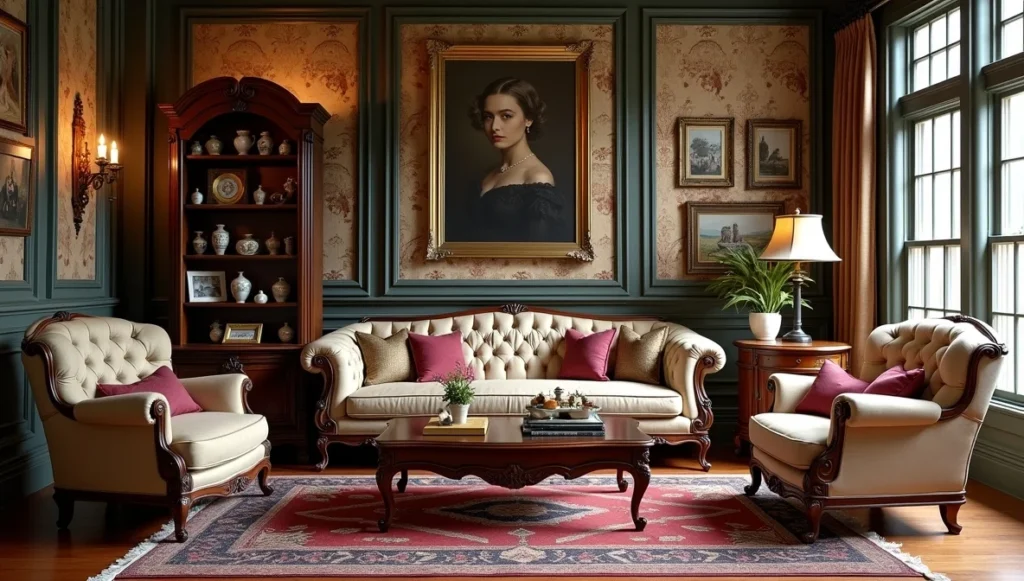
Dining Room Drama
Victorian dinner parties were productions, and the dining room was the stage. The table needed to seat everyone who mattered – eight was minimum, twelve was better. The sideboard was just as important, serving as both storage and display case for the family’s best china and silver.
Lighting made or broke the mood. A proper chandelier was essential – gas originally, then electric as it became available. But they also used candelabras and table lamps to create layers of light. Dinner by candlelight wasn’t romantic nostalgia; it was practical necessity.
The walls went dramatic here. Deep reds were popular, often with gold accents. Heavy drapes weren’t just decorative – they helped control drafts and outside noise during long dinner parties.
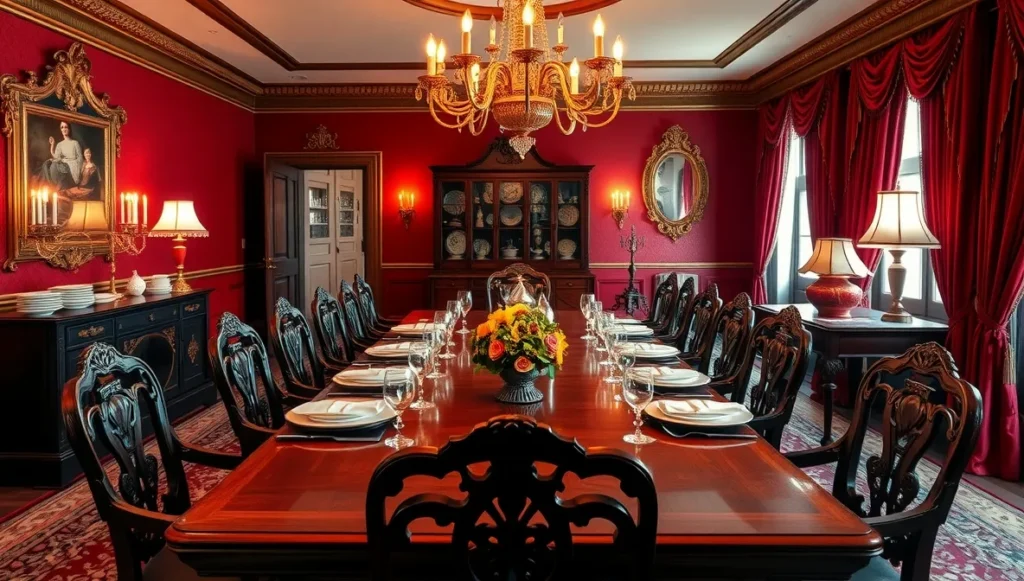
The Kitchen: From Servants’ Quarters to Family Heart
Victorian kitchens were tucked away where servants worked, but they had better workflow than most modern ones. I saw this in a Nob Hill restoration – the original 1890s kitchen had a central work table and floor-to-ceiling glass-front cabinets that displayed the family’s prosperity.
For modern Victorian kitchens, think substantial. A hefty central island with thick wood tops, raised panel cabinetry in dark wood or deep forest green, and glass-front uppers. Don’t shy away from patterned tile backsplashes – hexagonal or herringbone has more personality than plain subway tile.
The range was the kitchen’s altar. Choose a professional-style one in black or deep blue with brass accents, and layer your lighting like everywhere else – pendant lights, under-cabinet task lighting, brass and oil-rubbed bronze finishes.
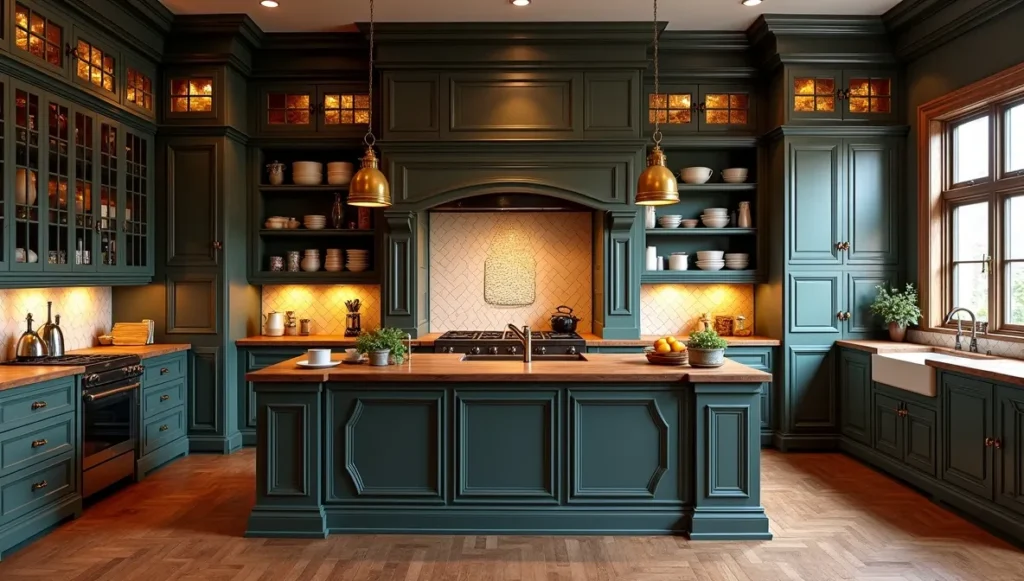
Bedrooms: Private Sanctuaries
Bedrooms could be softer since they were private spaces. This is where you’d see lighter colors – rose pink, lavender, sage green. The patterns got more delicate too – small florals, stripes, subtle geometrics.
The bed dominated everything else. High headboards were standard, whether carved wood or upholstered. They layered bedding like crazy – sheets, blankets, quilts, coverlets, all in coordinating patterns. It sounds excessive until you remember they didn’t have central heating.
Every bedroom had a proper dressing area. Ladies spent serious time on their appearance, and the dressing table with its elaborate mirror was command central. Men got simpler washstands, but even those had marble tops and decorative tiles.

Bathroom Luxury (For Those Who Could Afford It)
Indoor plumbing was still new and exciting. Those who had it showed it off. The famous clawfoot tub wasn’t just functional – it was a status symbol. Same with the high-tank toilet and the pedestal sink.
They kept things relatively simple color-wise. White fixtures were standard, but they added color through tiles, wallpaper, and accessories. Subway tiles were actually a Victorian innovation, originally used in New York’s underground railway system before making their way into homes.

Home Office: Victorian Command Central
Here’s a misconception – Victorians didn’t work from home. Wrong. I worked on a Pacific Heights mansion where the original home office had dark walnut paneling and a 300-pound desk worn smooth from generations of use.
The key is gravitas meets functionality. Start with a substantial wooden desk with real drawers. Built-in bookshelves floor to ceiling – books displayed intellect. A leather executive chair with button tufting tells visitors you mean business.
Keep colors masculine – deep browns, burgundies, forest greens. Layer lighting with brass desk lamps and wall sconces. The modern challenge is hiding technology behind panels while maintaining privacy with heavy drapes and substantial doors.
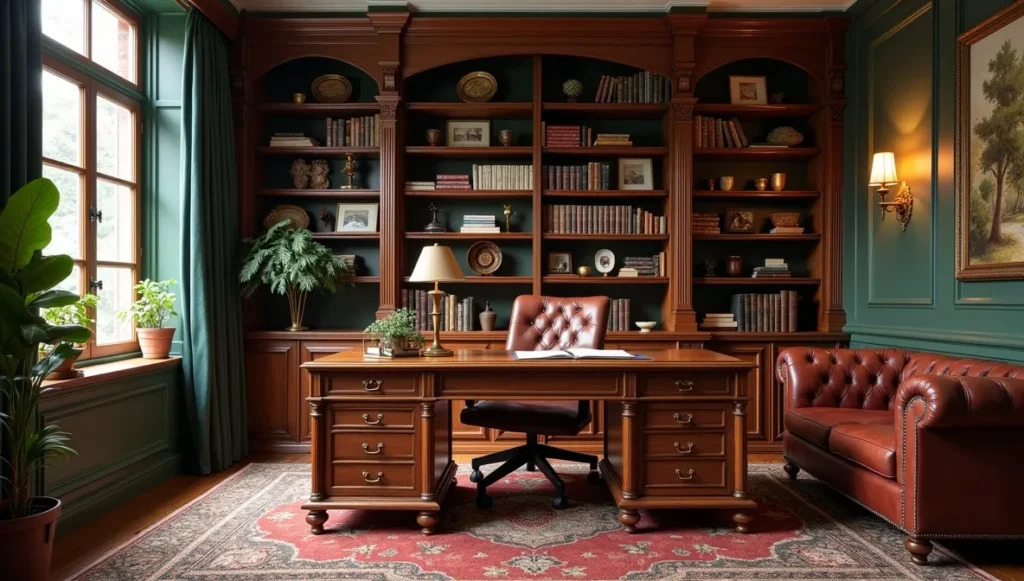
Lighting: More Than Just Pretty Fixtures
The transition from candles to gas to electricity happened during the Victorian era, and it completely changed how people used their homes. Gas lighting was revolutionary – consistent, bright, and relatively safe. When electricity arrived in the 1880s, it was like magic.
But here’s what’s important for today: Victorian rooms were designed for multiple lighting scenarios. They needed to work by daylight, gaslight, candlelight, and early electric bulbs. That’s why those rich colors and multiple patterns worked – they looked good under any kind of lighting.
Making It Work in Modern Homes
You don’t need a Victorian mansion to use Victorian design principles. I’ve done Victorian-inspired rooms in everything from studio apartments to modern tract homes. It’s about understanding what made the style work, not copying it exactly.
Pick your battles with color. You probably don’t want burgundy walls in every room, but you can use Victorian color principles as accents. A deep green accent wall, gold picture frames, rich burgundy throw pillows – these give you the Victorian richness without overwhelming a modern space.
Quality over quantity with furniture. One gorgeous antique piece has more impact than a roomful of reproductions. Hit the estate sales, check out antique stores, but buy the best you can afford.
Pattern mixing is still tricky, but it’s worth learning. Start small – maybe a floral wallpaper with a striped chair. Keep the colors related and vary the scale of the patterns.
What Victorians Got Right (And We Forgot)
They understood that your home should reflect your personality and interests. Every room told a story about the family – their travels, their accomplishments, their relationships. Modern minimalism has its place, but there’s something to be said for rooms that reveal something about the people who live there.
They also got quality. Victorian furniture that survived to today is still functional 150 years later. How much of our current stuff will last that long?
Most importantly, they designed for real life. Yes, the parlor was formal, but it got used. The dining room hosted weekly family dinners, not just special occasions. The bedrooms were retreats, but working retreats where people read, wrote letters, and spent time thinking.
That’s the real lesson of Victorian design – create rooms that are both beautiful and functional, that reflect your personality while serving your daily needs. The heavy patterns and rich colors are just the decoration. The real substance is in the thoughtful planning and quality execution that makes a house truly feel like home.
